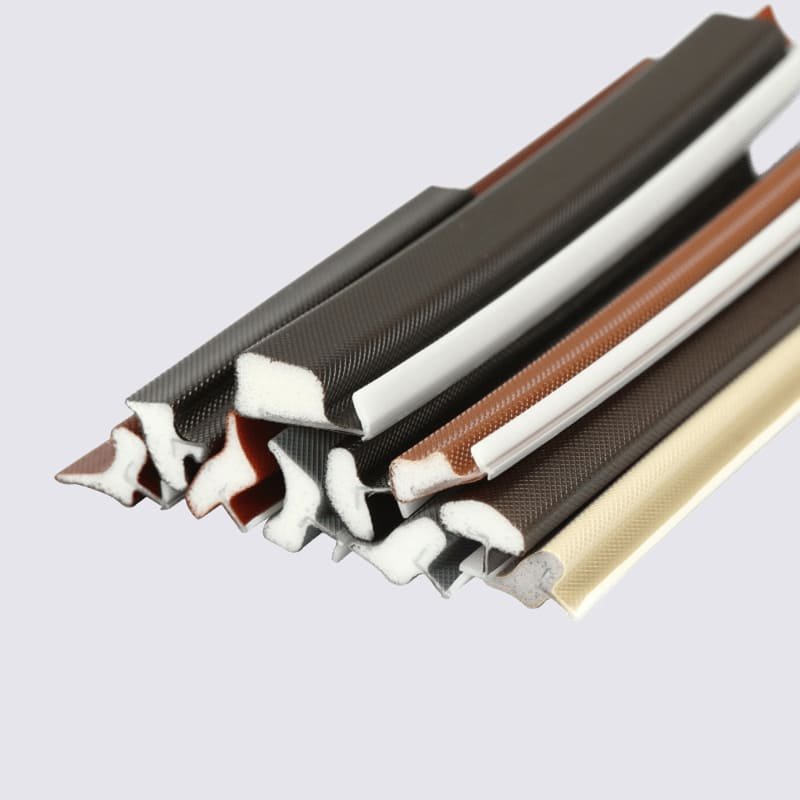Seal strips are an important part of doors, fuinneoga, and other entrances. They help to stop drafts, deannach, uisce, agus torann. When you use the right shape of seal strip, you can make sure that your project will last a long time and be well-insulated. There are many different shapes of seal strips. You can use them for different projects, whether you are a DIYer or a manufacturer. In this guide, we will look at the different shapes of seal strips, what they are good for, and when you should use them.
What is a U-Shape Seal Strip and Where Should It Be Used?
Description: U-shaped seals are flexible and shaped like the letter U, making them ideal for sealing larger, uneven gaps. They compress when closed to create a tight seal.
Buntáistí:
Blocks air, deannach, agus torann.
Cushions doors and windows from impact damage.
Feidhmchláir:
D-shaped strips are used for door frames, doirse carr, and even around windows to improve soundproofing and insulation.
E-Shape Seal Strips
Description: E-shaped seal strips are slim and compact, making them perfect for narrow gaps. Their shape allows for a tight, effective seal in confined areas.
Buntáistí:
Ideal for small gaps and tight spaces.
Cost-effective and easy to install.
Feidhmchláir:
E-shape strips are often used around windows and narrow gaps in doors, where a snug fit is crucial for energy efficiency.
T-Shape Seal Strips
Description: T-shaped seal strips are flat and versatile, fitting well along door bottoms and flat surfaces. They are broad and adhesive-backed, making them easy to install.
Buntáistí:
- They have a strong adhesive quality, so they provide a durable seal.
- They are easy to install, especially for DIYers.
Feidhmchláir:
T-shape seal strips are a popular choice for sealing out drafts at the bottom of doors in both residential and commercial settings.
P-Shape Seal Strips
Description:
P-strips have a bulb design that creates a strong, long-lasting seal. They are often used in areas where you need a good seal that will last.
Buntáistí:
- They are durable and can stand up to heavy use.
- They provide a good seal against air and moisture.
Feidhmchláir: They are great for garages, high-traffic doors, agus suímh thionsclaíocha, where you need something that will hold up and insulate well.
H-Shape Seal Strips
Description:
H-shaped seal strips are thick and strong, making them perfect for bigger, heavier applications. They’re built to last and provide excellent noise reduction and insulation.
Buntáistí:
Provides great insulation, especially for big gaps.
It is good at reducing noise in industrial settings.
Feidhmchláir:
H-shape strips are best for industrial uses, like big windows, partitions, and warehouse doors that need heavy-duty sealing.
L-Shape Seal Strips:
Description:
L-shaped seal strips are designed to fit into corners and right-angled edges, creating a seamless seal in hard-to-reach areas.
Buntáistí:
Great for creating a tight seal in cornered areas.
Easy to install along edges and frames.
Feidhmchláir:
L-shaped strips are often used for framing, window corners, and door jambs, where they provide a neat, séala slán.
J-Shape Seal Strips:
Description:
J-shaped seal strips are designed to bend and conform to irregular surfaces, making them perfect for doors and windows that don’t have straight edges.
Buntáistí:
- Flexibility allows for easy installation on odd shapes and curves.
- Simple to install, making them great for do-it-yourself (DIY) projects.
Feidhmchláir:
J-shaped strips are used around doors, fuinneoga, and frames that are not standard sizes to provide a custom fit.
V-Shape Seal Strips:
Description:
V-shape strips are self-adjusting and easily compress, making them versatile for a range of gaps. They provide an adaptable fit, sealing gaps that may vary in size.
Buntáistí:
- Self-adjusts to different gap sizes, providing flexibility.
- Energy-efficient, reducing heating and cooling costs.
Feidhmchláir:
V-shape strips are great for windows, door frames, and spaces where gaps may be inconsistent, providing a snug, adaptable seal.
How to Choose the Right Seal Strip Shape for Your Project
When choosing a door bottom shape, consider:
- Gap Size: Measure the width of the gap to determine the best shape.
- Traffic Frequency: For high-traffic areas, choose a more durable shape like a D or P.
- Environmental Conditions: If you’re using the door bottom outside, make sure it’s weather-resistant.
- Project Type: For DIY home projects, choose a shape like a T or J that’s easier to install. For industrial use, choose a heavy-duty shape like an H or U.
Installation Tips for DIY and Industrial Seal Strips
- Glan an Dromchla: Make sure the surface is clean and dry for the best stick.
- Measure Carefully: Take accurate measurements of the gap so you don’t waste material.
- Cut to Size: Use a sharp utility knife to cut the strip to the right length.
- Apply Firmly: Press the adhesive strip down hard so it sticks well.
Achoimre
Choosing the right shape for your weatherstripping can make a big difference in insulation, laghdú torainn, and overall comfort. Whether you’re a do-it-yourselfer or a manufacturer, understanding the applications and benefits of each shape will help you choose the best option for your needs. A well-chosen weatherstrip will improve energy efficiency and prolong the life of your doors, fuinneoga, agus eile.



